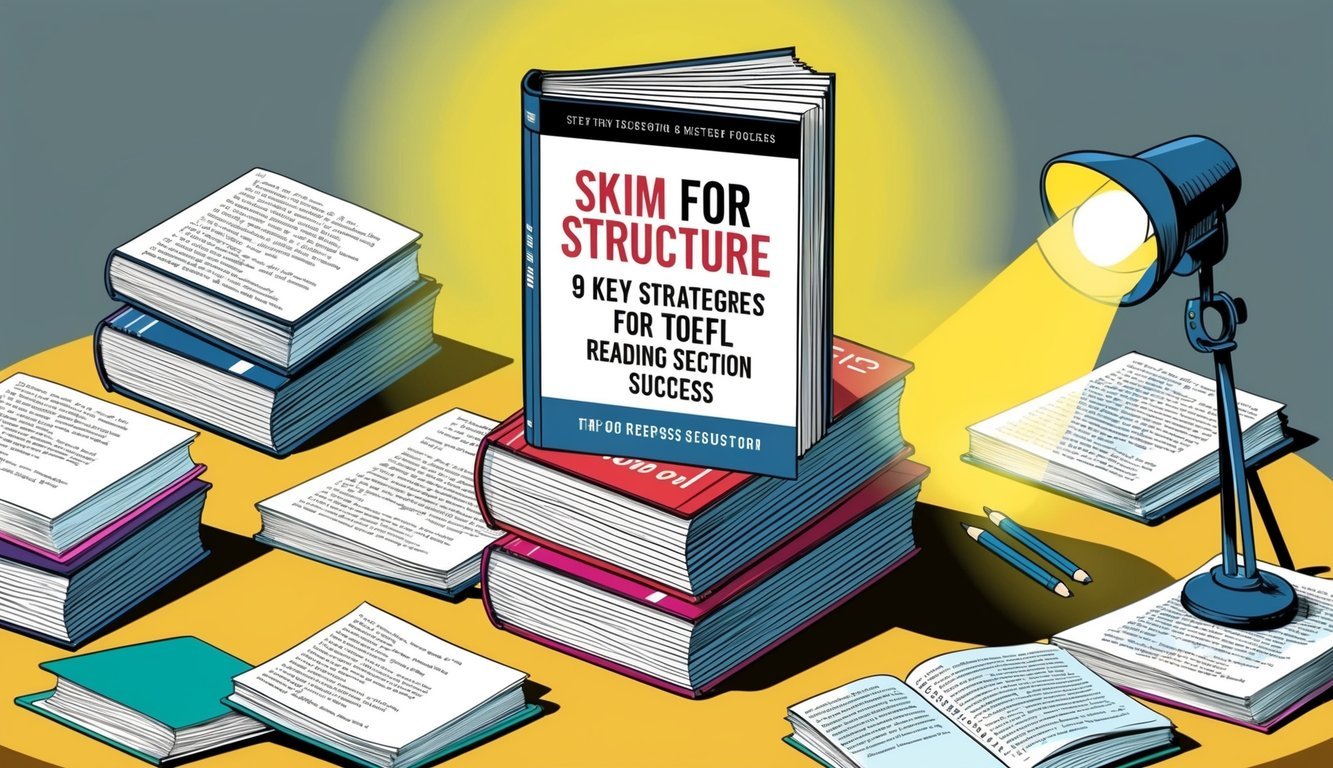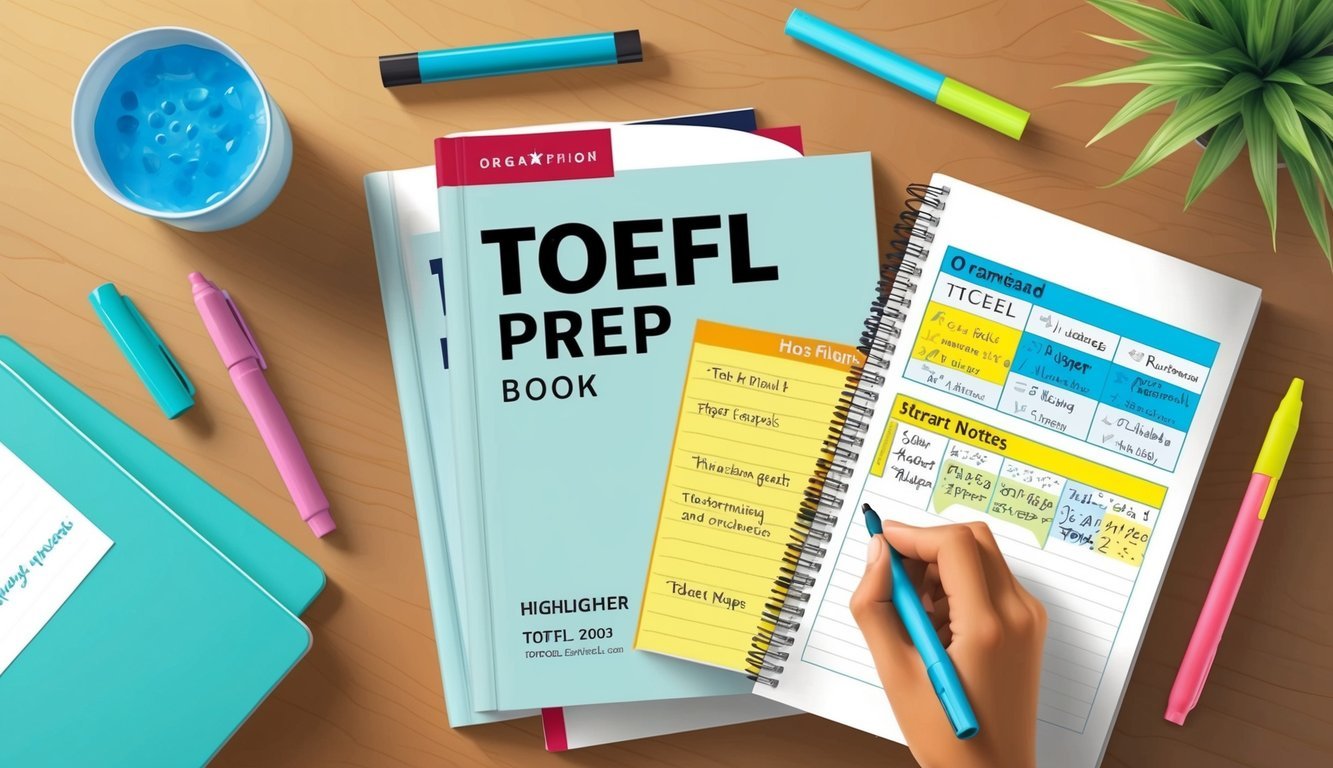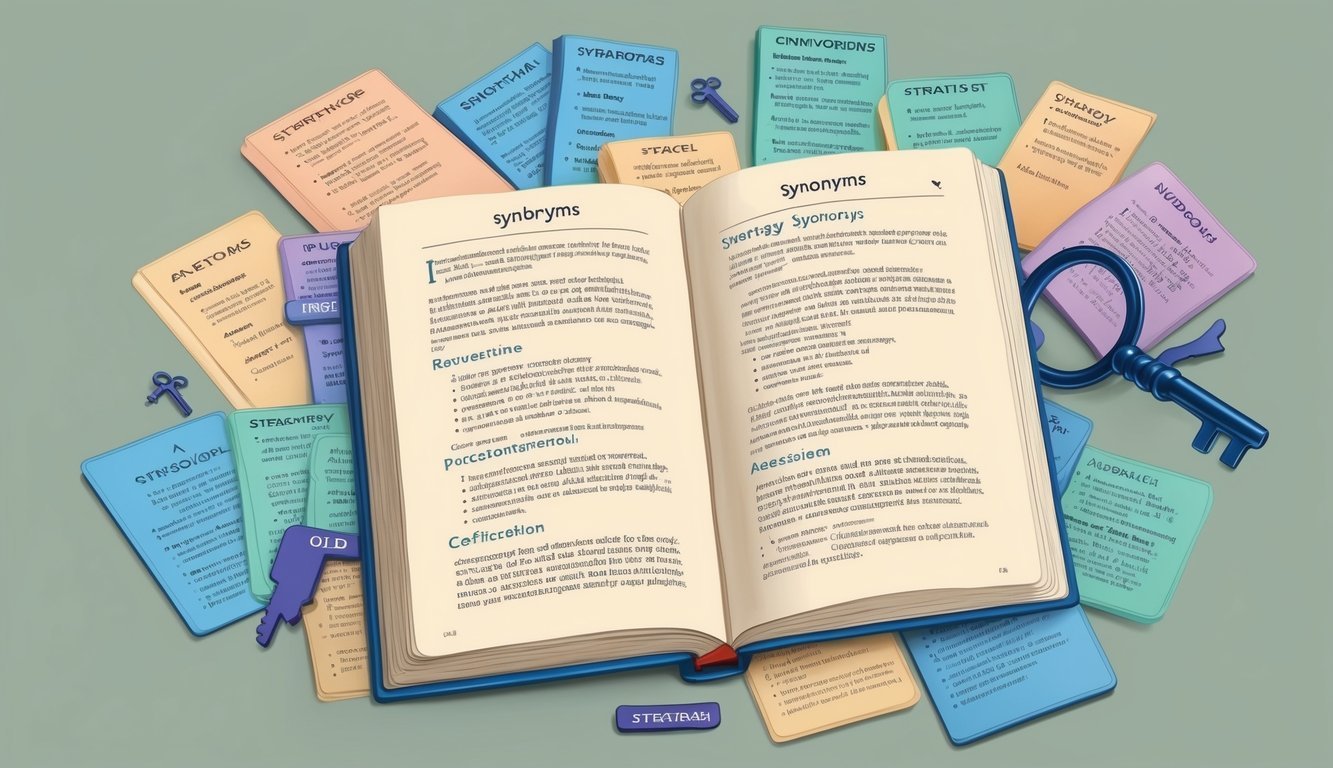The TOEFL Reading section can be a challenge, especially with its mix of academic texts and tricky questions.
Many test-takers often wonder how to improve their skills and boost their scores. By using the right strategies, you can enhance your reading comprehension and perform better on test day.

In this article, you will discover nine key strategies that can help you succeed in the TOEFL Reading section.
Each strategy focuses on essential skills you need to master.
With practice and the right approach, reaching your goals is totally achievable.
1) Skim for Structure

When you start reading a TOEFL passage, skimming for structure is a smart way to get the main ideas.
Look for headings, subheadings, and paragraph breaks.
This helps you see how the information is organized.
Pay attention to the first sentence of each paragraph.
These often contain the main point.
They give you a quick overview of what to expect.
Understanding the flow makes it easier to find details later.
Also, check for transition words like “however” or “because.” These words signal changes in ideas, helping you follow the writer’s logic.
Skimming saves time during the actual reading.
Knowing the structure allows you to focus on important details when you answer questions.
So, practice this technique to improve your reading speed and comprehension.
It’s a simple skill that can make a big difference in your TOEFL performance.
With practice, you’ll get better at spotting the structure quickly.
Focus on Keywords

When you read a passage for the TOEFL, focusing on keywords can make a big difference.
Keywords are the important words that help you understand the main ideas.
Look for nouns, verbs, and phrases that seem important.
These often hold the key to answering questions later.
When a question references the passage, your ability to spot these keywords will help you find the correct answer faster.
Highlight or underline these words as you read.
This will make it easier to locate them when you get to the questions.
Be careful with synonyms and paraphrases.
The test often uses different words to ask about the same idea.
Knowing the keywords will help you connect those dots and avoid confusion.
Lastly, practice this skill with sample passages.
The more you do it, the better you will get.
By honing in on those keywords, you’ll improve your reading speed and comprehension.
3) Practice Paraphrasing

Paraphrasing is an important skill for the TOEFL reading section.
It helps you show that you understand the main ideas of a passage using different words.
This skill is not just useful for reading; it can also boost your speaking and writing scores.
When you practice paraphrasing, try to rephrase sentences or passages in your own words.
This will help you avoid copying directly from the text.
Use synonyms and change the structure of the sentences to make them unique.
You can find practice exercises online that focus on paraphrasing.
Some websites offer targeted activities to help you build this skill.
For example, Better TOEFL Scores Blog provides useful tips and practice materials.
As you become more comfortable with paraphrasing, you’ll be better able to answer comprehension questions.
It can also make it easier to connect ideas within the passages.
The more you practice, the more confident you’ll feel on test day.
Master Time Management
Managing your time during the TOEFL reading section is crucial.
You have between 54 to 72 minutes to answer up to 40 questions.
This means you need to stay aware of the clock.
Start by skimming the passages first.
This helps you get a general sense of the content.
Then, focus on the questions.
Don’t spend too much time on any single question.
If you’re stuck, make an educated guess and move on.
Keep track of how much time you have left after every passage.
Aim to finish each one with enough time to review your answers.
You can use strategies like highlighting key information or taking notes to help you.
Practice is essential.
Try timed practice sessions that mirror the real test.
This will help you get used to pacing yourself.
By mastering time management, you can make the most of your reading section and boost your score.
Expand Vocabulary

Expanding your vocabulary is key to doing well in the TOEFL Reading section.
A strong vocabulary helps you understand passages better and answer questions more easily.
Start by reading a variety of materials in English, like articles and books.
This will expose you to new words in different contexts.
Use flashcards to memorize important terms.
Write the word on one side and its meaning on the other.
Review them regularly to reinforce your memory.
You can also try using apps that focus on vocabulary building.
These can make learning new words fun and interactive.
When you come across unfamiliar words in your readings, don’t skip over them.
Take the time to look up their meanings.
This will help make those words part of your vocabulary over time.
Practice using new words in your writing and speaking.
The more you use them, the more natural they will become.
6) Take Strategic Notes

Taking notes can help you remember important details during the TOEFL reading section.
You won’t be tested on your notes, but they guide your understanding of the passages.
Focus on main ideas, keywords, and any supporting evidence as you read.
This way, you can keep track of what each paragraph contributes to the passage.
Don’t worry about writing every single detail.
Instead, highlight points that connect to the questions you might face later.
This makes searching for answers easier when you go back to the text.
Try to jot down notes in the margins or use a separate sheet.
Use symbols or shorthand to save time.
While taking notes, stay calm.
You have the option to reread sections if needed, so you don’t have to write everything down perfectly.
Remember, your goal is to use notes as a tool for better comprehension.
You want them to support your reading, not become a distraction.
7) Look for Synonyms

When you tackle the TOEFL reading section, keep an eye out for synonyms.
These are words that have similar meanings.
Recognizing them can help you answer questions better.
Try to find synonyms in the passage and the answer choices.
For instance, if the text says “happy,” look for options like “joyful” or “cheerful.” They mean the same thing and can point you to the right answer.
Using synonyms can also help when a word in a question confuses you.
If you see “decrease,” think of “reduce” or “lessen.” This approach can guide you back to the passage for clues.
When you read, highlight or underline key phrases.
This will help you remember where you found important synonyms.
Plus, it’ll make skimming for answers much easier later on.
8) Use Process of Elimination
Using the process of elimination is a smart strategy for the TOEFL Reading section.
Instead of stressing over tough questions, start by looking at the answer choices.
Focus on the options that don’t fit with what you read.
If an answer seems a little off, cross it out.
This makes it easier to see the choices that are more likely correct.
Sometimes, you can be sure about one or two answers that are wrong.
By removing those, you narrow down your options.
This also boosts your chances of picking the right answer.
Using this method helps you stay calmer and more confident.
You don’t have to know everything; just filter out the choices that clearly don’t match the passage.
Practice this technique in your study sessions.
As you do, it will become a natural part of how you approach reading questions.
You might find that it saves you time and reduces pressure during the exam!
9) Identify Rhetorical Purpose
Identifying rhetorical purpose is key to understanding a passage in the TOEFL reading section.
It helps you figure out why the author wrote the text the way they did.
When you read, ask yourself why certain details are included.
This can reveal the author’s intent, whether it’s to inform, persuade, or entertain.
Paying attention to the big picture is crucial.
Look for clues in the text, like transition words or phrases.
These often highlight how ideas connect, making it easier to see the author’s purpose.
For example, words like “however” can signal a shift in the argument.
Practicing this skill will boost your comprehension and test performance.
Try summarizing the main point of a paragraph in your own words.
This will help reinforce your understanding of the author’s intent.
Regularly working on identifying rhetorical purpose can enhance your reading skills.
It helps you understand different perspectives and arguments, which is super valuable for the TOEFL.
Using Flashcards Effectively
Flashcards are a great way to memorize vocabulary.
You can make them by hand or use an app.
Write the word on one side and its definition or an example sentence on the other.
Review them regularly.
Set a daily goal, like ten new words each day.
Keep mixing old and new cards to reinforce what you’ve learned.
Consider adding images or synonyms that relate to the word.
This helps your brain create stronger connections.
Find a study partner to quiz each other.
This makes learning more interactive and fun.
By staying consistent, you’ll build a stronger vocabulary for the TOEFL.
Understanding Passage Structures
When reading TOEFL passages, it’s important to recognize how each one is structured.
Understanding these structures can help you quickly find the information you need.
You’ll want to focus on identifying key points and recognizing the author’s tone.
Identifying Key Points
Each passage typically has a main idea along with supporting details.
One effective way to find key points is to look for topic sentences.
These often appear at the beginning or end of paragraphs.
Tip: Highlight or take notes on these key sentences.
Also, pay attention to transition words like “however,” “furthermore,” and “in contrast.” They signal important ideas and show how points connect.
A simple list of what to look for:
- Main Idea: The central point of the passage.
- Supporting Details: Facts or examples that back up the main idea.
- Transitions: Words that indicate changes in ideas or points.
Recognizing the Author’s Tone
The author’s tone helps you gauge their attitude toward the subject.
Is it informative, critical, or enthusiastic? Tone can be detected through word choice and style.
Look for adjectives and specific phrases that reveal the author’s feelings.
For instance, words like “remarkable” or “disappointing” signal strong feelings about the subject.
Understanding tone can aid comprehension.
It sets the mood for how you’re expected to interpret the passage.
Frequently Asked Questions
Here are some common questions you might have about the TOEFL reading section.
These tips can help you sharpen your skills and increase your chances of success.
How can I quickly improve my TOEFL reading skills?
To boost your reading skills fast, practice skimming passages to understand their structure.
Focus on the main ideas, and read the first and last sentences of each paragraph.
This speeds up comprehension and helps you pick out important details.
What are the top strategies for tackling the TOEFL reading section effectively?
Using key strategies like focusing on keywords can make a big difference.
Identify important terms and phrases as you read.
This will help you answer questions more accurately and efficiently.
Are there any proven tips to score high in the TOEFL reading section?
One solid tip is to practice paraphrasing sentences.
It helps you get used to understanding different ways of expressing the same idea, which can be important for answering questions correctly.
What is considered the most challenging part of the TOEFL and how can I prepare for it?
Many students find time management the toughest aspect.
To prepare, practice completing passages within a set time limit.
This builds your confidence and helps you find a comfortable pace.
In what ways can I practice for the TOEFL reading section to ensure a passing score?
Consistent practice with sample reading passages is key.
Use TOEFL practice tests to simulate the actual exam conditions.
Focus on understanding the material quickly and accurately.
Can you recommend useful resources or materials for mastering the TOEFL reading section?
Look for online resources like TOEFL prep websites and practice books.
Websites that offer reading strategies and sample questions can be particularly helpful for mastering this section.

